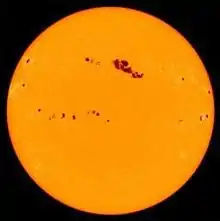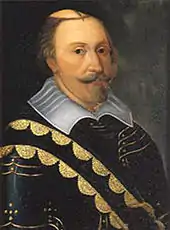1611
1611 (MDCXI) was a common year starting on Saturday of the Gregorian calendar and a common year starting on Tuesday of the Julian calendar, the 1611th year of the Common Era (CE) and Anno Domini (AD) designations, the 611th year of the 2nd millennium, the 11th year of the 17th century, and the 2nd year of the 1610s decade. As of the start of 1611, the Gregorian calendar was 10 days ahead of the Julian calendar, which remained in localized use until 1923.
| Millennium: | 2nd millennium |
|---|---|
| Centuries: | |
| Decades: | |
| Years: |
| 1611 by topic |
|---|
| Arts and science |
|
| Leaders |
|
| Birth and death categories |
| Births – Deaths |
| Establishments and disestablishments categories |
| Establishments – Disestablishments |
| Works category |
|
| Gregorian calendar | 1611 MDCXI |
| Ab urbe condita | 2364 |
| Armenian calendar | 1060 ԹՎ ՌԿ |
| Assyrian calendar | 6361 |
| Balinese saka calendar | 1532–1533 |
| Bengali calendar | 1018 |
| Berber calendar | 2561 |
| English Regnal year | 8 Ja. 1 – 9 Ja. 1 |
| Buddhist calendar | 2155 |
| Burmese calendar | 973 |
| Byzantine calendar | 7119–7120 |
| Chinese calendar | 庚戌年 (Metal Dog) 4307 or 4247 — to — 辛亥年 (Metal Pig) 4308 or 4248 |
| Coptic calendar | 1327–1328 |
| Discordian calendar | 2777 |
| Ethiopian calendar | 1603–1604 |
| Hebrew calendar | 5371–5372 |
| Hindu calendars | |
| - Vikram Samvat | 1667–1668 |
| - Shaka Samvat | 1532–1533 |
| - Kali Yuga | 4711–4712 |
| Holocene calendar | 11611 |
| Igbo calendar | 611–612 |
| Iranian calendar | 989–990 |
| Islamic calendar | 1019–1020 |
| Japanese calendar | Keichō 16 (慶長16年) |
| Javanese calendar | 1531–1532 |
| Julian calendar | Gregorian minus 10 days |
| Korean calendar | 3944 |
| Minguo calendar | 301 before ROC 民前301年 |
| Nanakshahi calendar | 143 |
| Thai solar calendar | 2153–2154 |
| Tibetan calendar | 阳金狗年 (male Iron-Dog) 1737 or 1356 or 584 — to — 阴金猪年 (female Iron-Pig) 1738 or 1357 or 585 |
Events
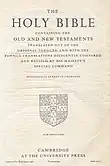
January–June
- February 27 – Sunspots are observed by telescope, by Frisian astronomers Johannes Fabricius and David Fabricius. Johannes publishes the results of these observations, in De Maculis in Sole observatis in Wittenberg, later this year.[1] Such early discoveries are overlooked, however, and the first sighting is claimed a few months later, by Galileo Galilei and Christoph Scheiner.
- March 4 – George Abbot is enthroned as Archbishop of Canterbury.[2]
- March 9 – Battle of Segaba in Begemder: Yemana Kristos, brother of Emperor of Ethiopia Susenyos I, ends the rebellion of Melka Sedeq.
- April 4 – Denmark-Norway declares war on Sweden, then captures Kalmar.
- April 28 – The Colegio de Nuestra Señora del Santísimo Rosario is established in Manila, the Philippines (later renamed Colegio de Santo Tomas, now known as the University of Santo Tomas).[3]
- May 2 – The Authorized King James Version of the Bible is published for the first time in London, England, printed by Robert Barker.
- May 9 – In Japan, sixteen-year-old Emperor Go-Mizunoo succeeds Emperor Go-Yōzei.
- June 22 – English explorer and sea captain Henry Hudson, his teenage son John, and seven crewmen are set adrift in or near Hudson Bay, after a mutiny on his ship Discovery. They are never seen again.
July–December
- August 2 – Jamestown: Deputy Governor Sir Thomas Gates returns to Virginia with 280 people, provisions and cattle on six ships and assumes control, ruling that the fort must be strengthened.
- September – Jamestown: Thomas Dale, with 350 men, starts building Henricus.
- October 30 – Gustavus Adolphus succeeds his father Charles IX as King of Sweden.
- November 1 – At Whitehall Palace in London, William Shakespeare's last solo play The Tempest is performed, perhaps for the first time.
Date unknown
- An uprising occurs in Moscow, Russia against occupying Polish forces, resulting in a major fire.
- Jamestown: John Rolfe imports tobacco seeds from the island of Trinidad (Nicotiana tabacum); the native tobacco is Nicotiana rustica.
- The Aix-en-Provence possessions takes place in France.
- Famine in Ethiopia resulting from crop failure due to weather conditions and the outbreak of a plague.
- Thomas Dale founds the city of Henricus on the James River, a few miles south of present day Richmond, Virginia.
- Construction begins on Naqsh-e Jahan Square in Isfahan, Persia.
- Thomas Sutton founds Charterhouse School, on the site of the old Carthusian monastery in Charterhouse Square, Smithfield, London.
- Itoh Gofuku Shop, a predecessor of Matsuzakaya, a famous department store, founded in Nagoya, Japan.
Births
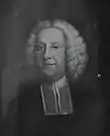
John Pell
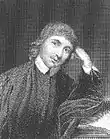
William Cartwright (dramatist)
January–March
- January 3 – James Harrington, English political theorist of classical republicanism (d. 1677)
- January 5 – Tsarevich Ivan Dmitriyevich, pretender to the Russian throne (d. 1614)
- January 28 – Johannes Hevelius, Polish astronomer (d. 1687)[4]
- February 2 – Ulrik of Denmark, Danish prince-bishop (d. 1633)
- February 3 – Christian Ulrik Gyldenløve, Danish diplomat and military officer (d. 1640)
- February 5 (bapt.) – Philip Sherman, English-born founder of Rhode Island (d. 1687)
- February 6 – Chongzhen Emperor of China (d. 1644)
- February 19 – Andries de Graeff, Dutch politician (d. 1678)
- February 24 (bapt.) – William Dobson (d. 1646)
- February 28 – William Brereton, 2nd Baron Brereton, English politician (d. 1664)
- March 1 – John Pell, English mathematician (d. 1685)
- March 9 – Pierre-Joseph-Marie Chaumonot, French missionary (d. 1693)
- March 15 – Jan Fyt, Flemish Baroque painter (d. 1661)
- March 17 – Robert Douglas, Count of Skenninge, Swedish field marshal (d. 1662)
- March 25 – Evliya Çelebi, Ottoman Turk, travelled around the Ottoman Empire for 40 years (d. 1682)
- March 28
April–June
- April 11 – Karl Eusebius, Prince of Liechtenstein (d. 1684)
- April 17 – Simone Pignoni, Italian painter (d. 1698)
- May 4 – Carlo Rainaldi, Italian architect (d. 1691)
- May 16 – Pope Innocent XI (d. 1689)[5]
- May 19 – Joachim Irgens von Westervick, Dano–Norwegian nobleman (d. 1675)
- June 15 – Salomon Sweers, Dutch businessman (d. 1674)
- June 22 – Pablo Bruna, blind Spanish composer and organist (d. 1679)
- June 24 – Johan Oxenstierna, Swedish count and statesman (d. 1657)
- June 28 – Robert Rich, 3rd Earl of Warwick (d. 1659)
July–September
- July 15 – Jai Singh I, Maharaja of Jaipur (d. 1667)
- July 16 – Cecilia Renata of Austria, Queen of Poland (d. 1644)
- July 21 – Jan van Balen, Flemish painter (d. 1654)
- July 23 – Henry Hungerford, English politician (d. 1673)
- July 24 – Giancarlo de' Medici, Italian Catholic cardinal (d. 1663)
- August 4 – Jan van den Hoecke, Dutch painter (d. 1651)
- August 9 – Henry of Nassau-Siegen, German count, officer in the Dutch Army, diplomat for the Dutch Republic (d. 1652)
- September 1 – William Cartwright, English dramatist (d. 1643)
- September 3 – Toussaint Rose, French writer (d. 1701)
- September 4 – George III of Brieg, Duke of Brzeg (1633–1664) (d. 1664)
- September 8 – Johann Friedrich Gronovius, German classical scholar (d. 1671)
- September 11 – Henri de la Tour d'Auvergne, Vicomte de Turenne (d. 1675)[6]
- September 17 – Johann Olearius, German hymnwriter (d. 1684)
October–December
- October 1 – Mathias Balen, Dutch writer (d. 1691)
- October 11
- October 22 – Jacques Esprit, French writer (d. 1677)
- October 26
- November 1
- November 12 – Joachim Gersdorff, Danish politician (d. 1661)
- November 18 – Andreas Tscherning, German poet (d. 1659)
- December 23 – Abraham Wright, English theological writer and deacon (d. 1690)
- December – Leonora Baroni, Italian singer (d. 1670)
Date unknown
Probable
- Charles de Batz-Castelmore d'Artagnan, French count and musketeer, on whom the fictional D'Artagnan from the novel The Three Musketeers is based (d. 1673)
Deaths

Juan de Ribera
.jpg.webp)
Christian II, Elector of Saxony

Eleanor de' Medici
January–March
- January 6 – Juan de Ribera, Spanish Catholic archbishop (b. 1532)
- January 16 – Niiro Tadamoto, Japanese samurai (b. 1526)
- February 7 – Ruprecht von Eggenberg, Austrian general (b. 1546)
- February 12 – Henry Lee of Ditchley, English noble (b. 1533)
- February 26 – Antonio Possevino, Italian Jesuit protagonist of Counter Reformation, papal diplomat (b. 1533)
- March 2 – Ernest II, Duke of Brunswick-Lüneburg, (b. 1564)
- March 3 – William Douglas, 10th Earl of Angus, son of William Douglas (b. 1552)
- March 5 – Shimazu Yoshihisa, Japanese warlord and samurai (b. 1533)
- March 13 – Louis III, Count of Löwenstein (1541–1611) (b. 1530)
- March 17 – Princess Sophia of Sweden (b. 1547)
- March 20 – Johann Georg Gödelmann, German demonologist (b. 1559)
April–June
July–September
- July 9 – János Imreffy, Hungarian politician (b. 1559)
- July 26 – Horio Yoshiharu, Japanese warlord (b. 1542)
- August – Antoni Clarassó i Terès, Spanish priest
- August 2 – Katō Kiyomasa, Japanese warlord and samurai (b. 1561)
- August 9 – John Blagrave, English mathematician (b. 1561)
- August 12 – Herman van den Bergh, Dutch soldier in the Eighty Years' War (b. 1558)
- August 27 – Tomás Luis de Victoria, Spanish composer (b. c. 1548)[8]
- September 9 – Eleanor de' Medici, Italian noblewoman (b. 1567)
- September 17 – Johannes Corputius, Dutch engineer, cartographer and military leader (b. 1542)
- September 18 – John Augustus, Count Palatine of Lützelstein, German count (b. 1575)
- September 25 – Šurhaci, Chinese prince (b. 1564)
October–December
- October 3
- October 11 – Thomas Blague, English priest and writer (b. 1545)
- October 30 – King Charles IX of Sweden (b. 1550)[9]
- November 6 – Peter Vok, Czech noble (b. 1539)
- November 17 – Nicolas Henri, Duke of Orléans, French duke (b. 1607)
- November 22 – Thomas Berkeley, English politician (b. 1575)
Date unknown
- Camillo Mariani, Italian sculptor (b. 1565)
- Tiryaki Hasan Pasha, Turkish beylerbey
- Henry Hudson, English explorer[10]
References
- Thony, C. (January 8, 2011). "Spotting the spots". The Renaissance Mathematicus. Archived from the original on July 21, 2011. Retrieved August 9, 2011.
- Charles Hole (1910). A Manual of English Church History. Longmans, Green, and Company. p. 278.
- Domingo Abella (1978). From Indio to Filipino: And Some Historical Works. M. Romualdez-Abella. p. 196.
- Ivan Volkoff; Ernest Franzgrote; A. Dean Larsen (1971). Johannes Hevelius and his catalog of stars. Brigham Young University Press. p. 7.
- The New Schaff-Herzog Encyclopedia of Religious Knowledge. Baker Book House. 1977. p. 507. ISBN 978-0-8010-7947-4.
- The Army Quarterly. William Clowes & Sons, Limited. 1923. p. 35.
- Campbell, Gordon (January 1, 2005). "Bertaut, Jean". The Oxford Dictionary of the Renaissance. Oxford University Press. doi:10.1093/acref/9780198601753.001.0001/acref-9780198601753-e-424. Retrieved June 8, 2022.
- Christopher Baker (2002). Absolutism and the Scientific Revolution, 1600-1720: A Biographical Dictionary. Greenwood Publishing Group. p. 391. ISBN 978-0-313-30827-7.
- Michael Conforti; Guy Walton; National Gallery of Art (U.S.) (1988). Sweden: A Royal Treasury, 1550-1700. National Gallery of Art. p. 88. ISBN 978-0-89468-111-0.
- The Independent. Independent Publications, Incorporated. July 1909. p. 700.
This article is issued from Wikipedia. The text is licensed under Creative Commons - Attribution - Sharealike. Additional terms may apply for the media files.
